Foodshed as an Example of Preliminary Research for Conducting Environmental Carrying Capacity Analysis
Abstract
:1. Introduction
2. Materials and Methods
2.1. Study Area
2.2. Analysis Database
2.3. Determining the Framework of Data Analysis
2.4. Determining a Framework of Foodshed Assessment
3. Results
3.1. Data Analysis Results
3.2. Foodshed Boundary Determination
4. Discussion
5. Conclusions
Acknowledgments
Author Contributions
Conflicts of Interest
References
- U’Thant, S. Report of Secretary-General UN on May 26, 1969, Problems of the Human Environment; United Nation, Economic and Social Council: New York, NY, USA, 1969. [Google Scholar]
- Edelman, D.J. Carrying Capacity Based Regional Planning. Available online: https://repub.eur.nl/pub/32680 (accessed on 20 March 2018).
- United Nations Environment Programme. Global Environment Outlook 5; United Nations Environment Programme: Nairobi, Kenya, 2014. [Google Scholar]
- Izakovičová, Z.; Mederly, P.; Petrovič, F. Long-Term Land Use Changes Driven by Urbanisation and Their Environmental Effects (Example of Trnava City, Slovakia). Sustainability 2017, 9, 1553. [Google Scholar] [CrossRef]
- Hełdak, M.; Płuciennik, M. Costs of Urbanisation in Poland, Based on the Example of Wrocław. IOP Conf. Ser. Mater. Sci. Eng. 2017, 245, 72003. [Google Scholar] [CrossRef]
- Folke, C.; Jansson, A.; Larsson, J.; Costanza, R. Ecosystem Appropriation by Cities. Ambio 1997, 26, 167–172. [Google Scholar]
- Rothwell, A.; Ridoutt, B.; Page, G.; Bellotti, W. Feeding and housing the urban population: Environmental impacts at the peri-urban interface under different land-use scenarios. Land Use Policy 2015, 48, 377–388. [Google Scholar] [CrossRef]
- McPhearson, T.; Pickett, S.T.A.; Grimm, N.B.; Niemelä, J.; Alberti, M.; Elmqvist, T.; Weber, C.; Haase, D.; Breuste, J.; Qureshi, S. Advancing Urban Ecology toward a Science of Cities. Bioscience 2016, 66, 198–212. [Google Scholar] [CrossRef]
- Heldak, M.; Szczepanski, J.; Pluciennik, M.; Stacherzak, A. Planning decisions in landslide areas. J. Ecol. Eng. 2016, 17, 218–227. [Google Scholar] [CrossRef]
- Dubbeling, M.; Carey, J.; Hochberg, K. The Role of Private Sector in City Region Food Systems. Analysis Report; RUAF Foundation: Leusden, The Netherlands, 2016. [Google Scholar]
- United Nations. Draft Outcome Document of the United Nations Summit for the Adoption of the Post-2015 Development Agenda; United Nations: New York, NY, USA, 2015. [Google Scholar]
- Liu, R.Z.; Borthwick, A.G.L. Measurement and assessment of carrying capacity of the environment in Ningbo, China. J. Environ. Manag. 2011, 92, 2047–2053. [Google Scholar] [CrossRef] [PubMed]
- Fogel, P. Opracowanie Kryteriów Chłonności Ekologicznej dla Potrzeb Planowania Przestrzennego Raport Końcowy. Instytut Gospodarki Przestrzennej i Mieszkalnictwa (Development of Ecological Absorption Criteria for Spatial Planning. The Final Report. Institute of Spatial Management and Housing); Instytut Gospodarki Przestrzennej i Mieszkalnictwa [Institute of Spatial Management and Housing]: Warszawa, Poland, 2005.
- Santoso, E.B.; Erli, H.K.D.M.; Aulia, B.U.; Ghozali, A. Concept of Carrying Capacity: Challenges in Spatial Planning (Case Study of East Java Province, Indonesia). Procedia Soc. Behav. Sci. 2014, 135, 130–135. [Google Scholar] [CrossRef]
- Wei, Y.; Huang, C.; Lam, P.; Sha, Y.; Feng, Y. Using Urban-Carrying Capacity as a Benchmark for Sustainable Urban Development: An Empirical Study of Beijing. Sustainability 2015, 7, 3244–3268. [Google Scholar] [CrossRef]
- Watson, V. “The planned city sweeps the poor away…”: Urban planning and 21st century urbanisation. Prog. Plan. 2009, 72, 151–193. [Google Scholar] [CrossRef]
- Broere, W. Urban underground space: Solving the problems of today’s cities. Tunn. Undergr. Space Technol. 2016, 55, 245–248. [Google Scholar] [CrossRef]
- Solecka, I.; Sylla, M.; Świąder, M. Urban Sprawl Impact on Farmland Conversion in Suburban Area of Wroclaw, Poland. IOP Conf. Ser. Mater. Sci. Eng. 2017, 245, 72002. [Google Scholar] [CrossRef]
- Cohen, B. Urbanization in developing countries: Current trends, future projections, and key challenges for sustainability. Technol. Soc. 2006, 28, 63–80. [Google Scholar] [CrossRef]
- Carter, J.G.; Cavan, G.; Connelly, A.; Guy, S.; Handley, J.; Kazmierczak, A. Climate change and the city: Building capacity for urban adaptation. Prog. Plan. 2015, 95, 1–66. [Google Scholar] [CrossRef] [Green Version]
- Seidl, I.; Tisdell, C.A. Carrying capacity reconsidered: From Malthus’ population theory to cultural carrying capacity. Ecol. Econ. 1999, 31, 395–408. [Google Scholar] [CrossRef]
- Belčáková, I.; Diviaková, A.; Belaňová, E. Ecological Footprint in relation to Climate Change Strategy in Cities. IOP Conf. Ser. Mater. Sci. Eng. 2017, 245. [Google Scholar] [CrossRef]
- Rees, W.E. Ecological footprints and appropriated carrying capacity: What urban economics leaves out. Environ. Urban. 1992, 4, 121–130. [Google Scholar] [CrossRef]
- Sali, G.; Corsi, S.; Mazzocchi, C.; Monaco, F.; Wascher, D.; Van Eupen, M.; Zasada, I. FoodMetres Analysis of Food Demand and Supply in the Metropolitan Region. Available online: http://www.foodmetres.eu/wp-content/uploads/2014/05/D2.1-Analysis-of-food-demand-and-supply.pdf (accessed on 19 March 2018).
- Monfreda, C.; Wackernagel, M.; Deumling, D. Establishing national natural capital accounts based on detailed Ecological Footprint and biological capacity assessments. Land Use Policy 2004, 21, 231–246. [Google Scholar] [CrossRef]
- Wackernagel, M.; Monfreda, C.; Moran, D.; Wermer, P.; Goldfinger, S.; Deumling, D.; Murray, M. National Footprint and Biocapacity Accounts 2005: The Underlying Calculation Method; Global Footprint Network: Oakland, CA, USA, 2005. [Google Scholar]
- Moran, D.D.; Wackernagel, M.; Kitzes, J.A.; Goldfinger, S.H.; Boutaud, A. Measuring sustainable development—Nation by nation. Ecol. Econ. 2008, 64, 470–474. [Google Scholar] [CrossRef]
- Niccolucci, V.; Tiezzi, E.; Pulselli, F.M.; Capineri, C. Biocapacity vs. Ecological Footprint of world regions: A geopolitical interpretation. Ecol. Indic. 2012, 16, 23–30. [Google Scholar] [CrossRef]
- Budihardjo, S.; Hadi, S.P.; Sutikno, S.; Purwanto, P.; Al, E.T. The Ecological Footprint Analysis for Assessing Carrying Capacity of Industrial Zone in Semarang. J. Hum. Resour. Sustain. Stud. 2013, 2013, 14–20. [Google Scholar] [CrossRef]
- Galli, A. On the rationale and policy usefulness of ecological footprint accounting: The case of Morocco. Environ. Sci. Policy 2015, 48, 210–224. [Google Scholar] [CrossRef]
- Baabou, W.; Grunewald, N.; Ouellet-Plamondon, C.; Gressot, M.; Galli, A. The Ecological Footprint of Mediterranean cities: Awareness creation and policy implications. Environ. Sci. Policy 2017, 69, 94–104. [Google Scholar] [CrossRef]
- Wackernagel, M.; Rees, W. Our Ecological Footprint: Reducing Human Impact on the Earth; New Society Publisher: Gabriola Island, BC, Canada, 1998. [Google Scholar]
- Karg, H.; Drechsel, P.; Akoto-Danso, E.; Glaser, R.; Nyarko, G.; Buerkert, A. Foodsheds and City Region Food Systems in Two West African Cities. Sustainability 2016, 8, 1175. [Google Scholar] [CrossRef]
- Zasada, I.; Schmutz, U.; Wascher, D.; Kneafsey, M.; Corsi, S.; Mazzocchi, C.; Monaco, F.; Boyce, P.; Doernberg, A.; Sali, G.; et al. Food beyond the city—Analysing foodsheds and self-sufficiency for different food system scenarios in European metropolitan regions. City Cult. Soc. 2017. [Google Scholar] [CrossRef]
- Blum-Evitts, S. Designing a Foodshed Assessment Model: Guidance for Local and Regional Planners in Understanding Local Farm Capacity in Comparison to Local Food Needs; University of Massachusetts Amherst: Amherst, MA, USA, 2009. [Google Scholar]
- De Zeeuw, H.; Dubbeling, M. Process and tools for multi-stakeholder planning of the urban agro-food system. In Cities and Agriculture—Developing Resilient Urban Food Systems; de Zeeuw, H., Drechsel, P., Eds.; Routledge: Abingdon, UK, 2015; pp. 56–87. ISBN 9781315716312. [Google Scholar]
- Butler, M. Analyzing the Foodshed: Toward a More Comprehensive Foodshed Analysis. Master’s Thesis, Portland State University, Portland, OR, USA, 2013. [Google Scholar]
- Chen, S. Civic Agriculture: Towards a Local Food Web for Sustainable Urban Development. APCBEE Procedia 2012, 1, 169–176. [Google Scholar] [CrossRef]
- Richardson, J.J.; Moskal, L.M. Urban food crop production capacity and competition with the urban forest. Urban For. Urban Green. 2016, 15, 58–64. [Google Scholar] [CrossRef]
- Sonnino, R. The cultural dynamics of urban food governance. City Cult. Soc. 2017. [Google Scholar] [CrossRef]
- Moustier, P.; Renting, H. Urban agriculture and short chain food marketing in developing countries. In Cities and Agriculture—Developing Resilient Urban Food Systems; de Zeeuw, H., Drechsel, P., Eds.; Earthscan Publications Ltd.: London, UK, 2015; pp. 121–138. [Google Scholar]
- Saha, M.; Eckelman, M.J. Landscape and Urban Planning Growing fresh fruits and vegetables in an urban landscape: A geospatial assessment of ground level and rooftop urban agriculture potential in Boston, USA. Landsc. Urban Plan. 2017, 165, 130–141. [Google Scholar] [CrossRef]
- Moghadam, S.T.; Delmastro, C.; Lombardi, P.; Corgnati, S.P. Towards a New Integrated Spatial Decision Support System in Urban Context. Procedia Soc. Behav. Sci. 2016, 223, 974–981. [Google Scholar] [CrossRef]
- Szewrański, S.; Kazak, J.; Żmuda, R.; Wawer, R. Indicator-Based Assessment for Soil Resource Management in the Wrocław Larger Urban Zone of Poland. Pol. J. Environ. Stud. 2017, 26, 2239–2248. [Google Scholar] [CrossRef]
- Kazak, J.K. Scenariusze Zamian Zagospodarowania Przestrzennego i Ocena ich Skutków Środowiskowych na Przykładzie Strefy Podmiejskiej Wrocławia. [Scenarios for Changes in Land Use Development and Assessment of Their Environmental Impact: The Case of the Wrocław Suburban Zone]; Uniwersytet Przyrodniczy we Wrocławiu, Wydział Inżynierii Kształtowania Środowiska i Geodezji [Wrocław University of Environmental and Life Sciences, Faculty of Environmental Engineering and Geodesy]: Wrocław, Poland, 2016. [Google Scholar]
- European Comission. The Polish Food Basket; European Comission: Brussels, Belgium, 2015. [Google Scholar]
- Szewrański, S.; Kazak, J.; Sylla, M.; Świąder, M. Spatial Data Analysis with the Use of ArcGIS and Tableau Systems; Springer: Berlin, Germany, 2017; pp. 337–349. [Google Scholar]
- Steinbach, M.; Karypis, G.; Kumar, V. A Comparison of Document Clustering Techniques. Available online: https://www.researchgate.net/publication/2628533_A_Comparison_of_Document_Clustering_Techniques (accessed on 19 March 2018).
- Motavalli, P.; Nelson, K.; Udawatta, R.; Jose, S.; Bardhan, S. Global achievements in sustainable land management. Int. Soil Water Conserv. Res. 2013, 1, 1–10. [Google Scholar] [CrossRef]
- Przybyła, K.; Kulczyk-Dynowska, A.; Kachniarz, M. Quality of Life in the Regional Capitals of Poland. J. Econ. Issues 2014, 48, 181–196. [Google Scholar] [CrossRef]
- Isman, M.; Archambault, M.; Racette, P.; Konga, C.N.; Llaque, R.M.; Lin, D.; Iha, K.; Ouellet-Plamondon, C.M. Ecological Footprint assessment for targeting climate change mitigation in cities: A case study of 15 Canadian cities according to census metropolitan areas. J. Clean. Prod. 2018, 174, 1032–1043. [Google Scholar] [CrossRef]
- Bouma, J. Land quality indicators of sustainable land management across scales. Agric. Ecosyst. Environ. 2002, 88, 129–136. [Google Scholar] [CrossRef]
- Tokarczyk-Dorociak, K.; Kazak, J.; Szewrański, S. The Impact of a Large City on Land Use in Suburban Area—The Case of Wrocław (Poland). J. Ecol. Eng. 2018, 19, 89–98. [Google Scholar] [CrossRef]
- Dabek, P.; Zmuda, R.; Cmielewski, B.; Szczepanski, J. Analysis of water erosion processes using terrestrial laser scanning. ACTA Geodyn. Geomater. 2014, 11, 45–52. [Google Scholar] [CrossRef]
- Galli, A.; Halle, M.; Grunewald, N. Physical limits to resource access and utilisation and their economic implications in Mediterranean economies. Environ. Sci. Policy 2015, 51, 125–136. [Google Scholar] [CrossRef]
- Fraser, E.D.G.; Dougill, A.J.; Mabee, W.E.; Reed, M.; McAlpine, P. Bottom up and top down: Analysis of participatory processes for sustainability indicator identification as a pathway to community empowerment and sustainable environmental management. J. Environ. Manag. 2006, 78, 114–127. [Google Scholar] [CrossRef] [PubMed]
- DuPuis, E.M.; Goodman, D. Should we go “home” to eat? Toward a reflexive politics of localism. J. Rural Stud. 2005, 21, 359–371. [Google Scholar] [CrossRef]
- Donald, B.; Gertler, M.; Gray, M.; Lobao, L. Re-regionalizing the food system? Camb. J. Reg. Econ. Soc. 2010, 3, 171–175. [Google Scholar] [CrossRef]
- Bellows, A.C.; Hamm, M.W. Local autonomy and sustainable development: Testing import substitution in more localized food systems. Agric. Hum. Values 2001, 18, 271–284. [Google Scholar] [CrossRef]
- Peters, C.J.; Bills, N.L.; Lembo, A.J.; Wilkins, J.L.; Fick, G.W. Mapping potential foodsheds in New York State: A spatial model for evaluating the capacity to localize food production. Renew. Agric. Food Syst. 2009, 24, 72–84. [Google Scholar] [CrossRef]
- Lengnick, L.; Miller, M.; Marten, G.G. Metropolitan foodsheds: A resilient response to the climate change challenge? J. Environ. Stud. Sci. 2015, 5, 573–592. [Google Scholar] [CrossRef]

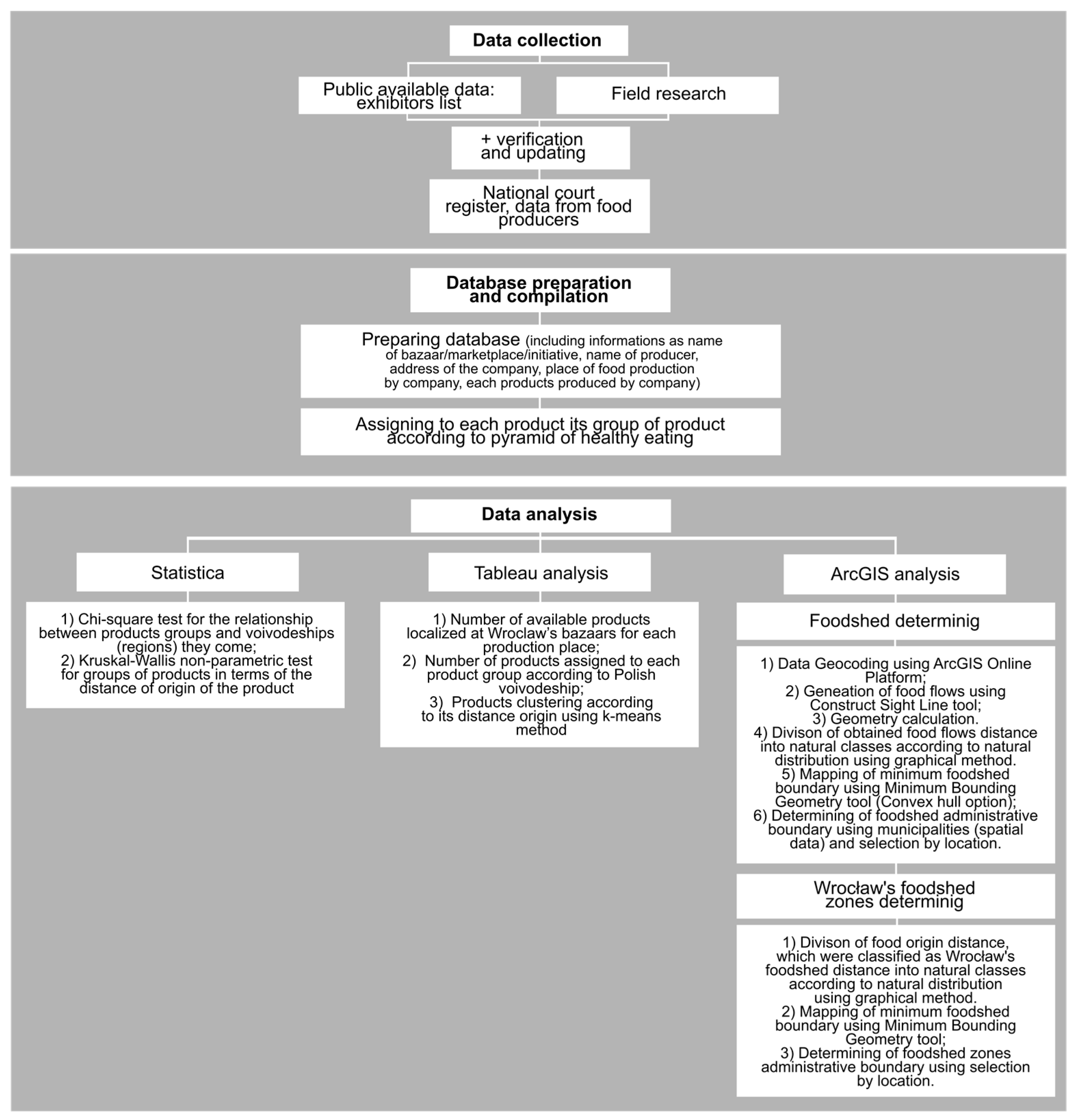
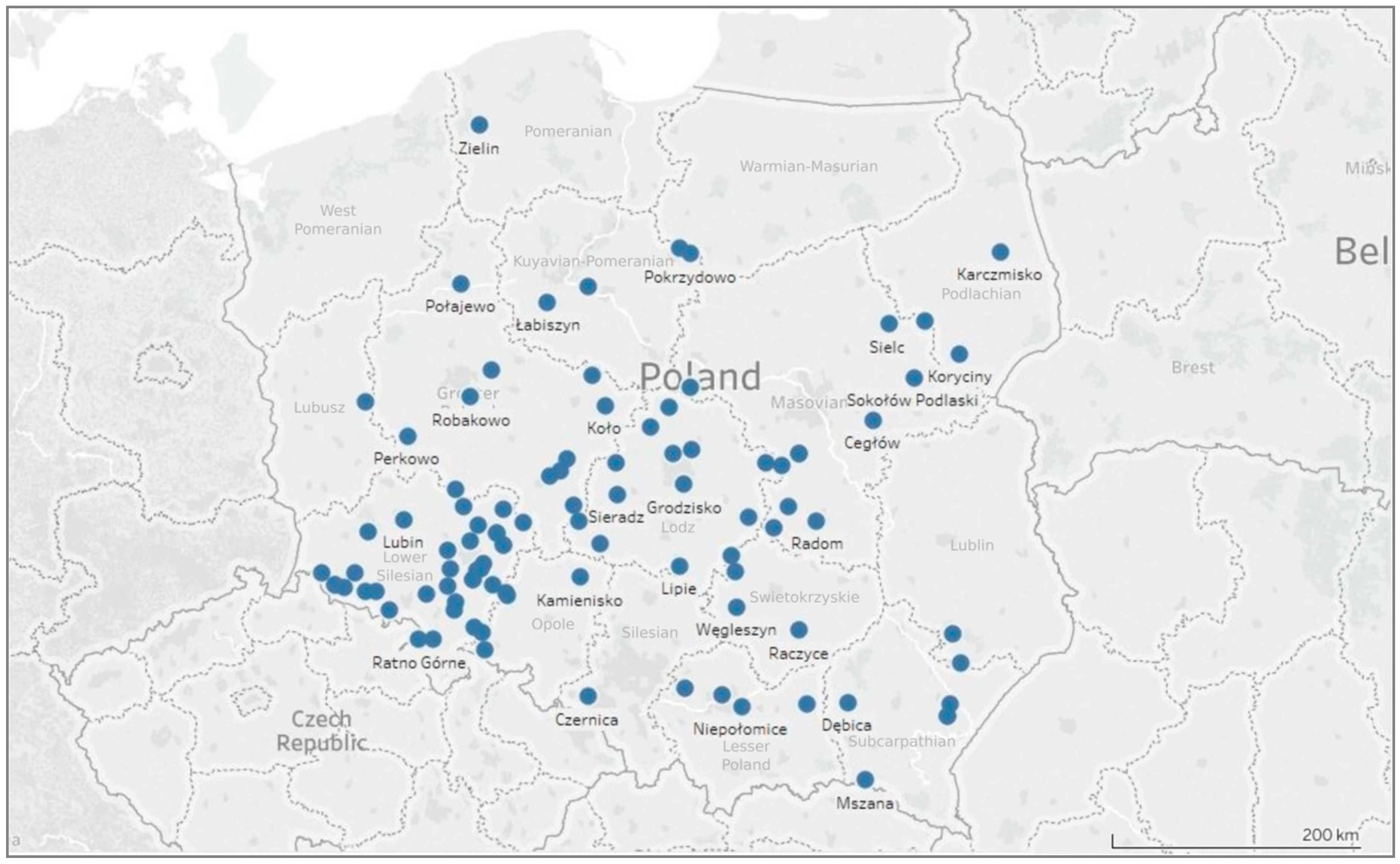
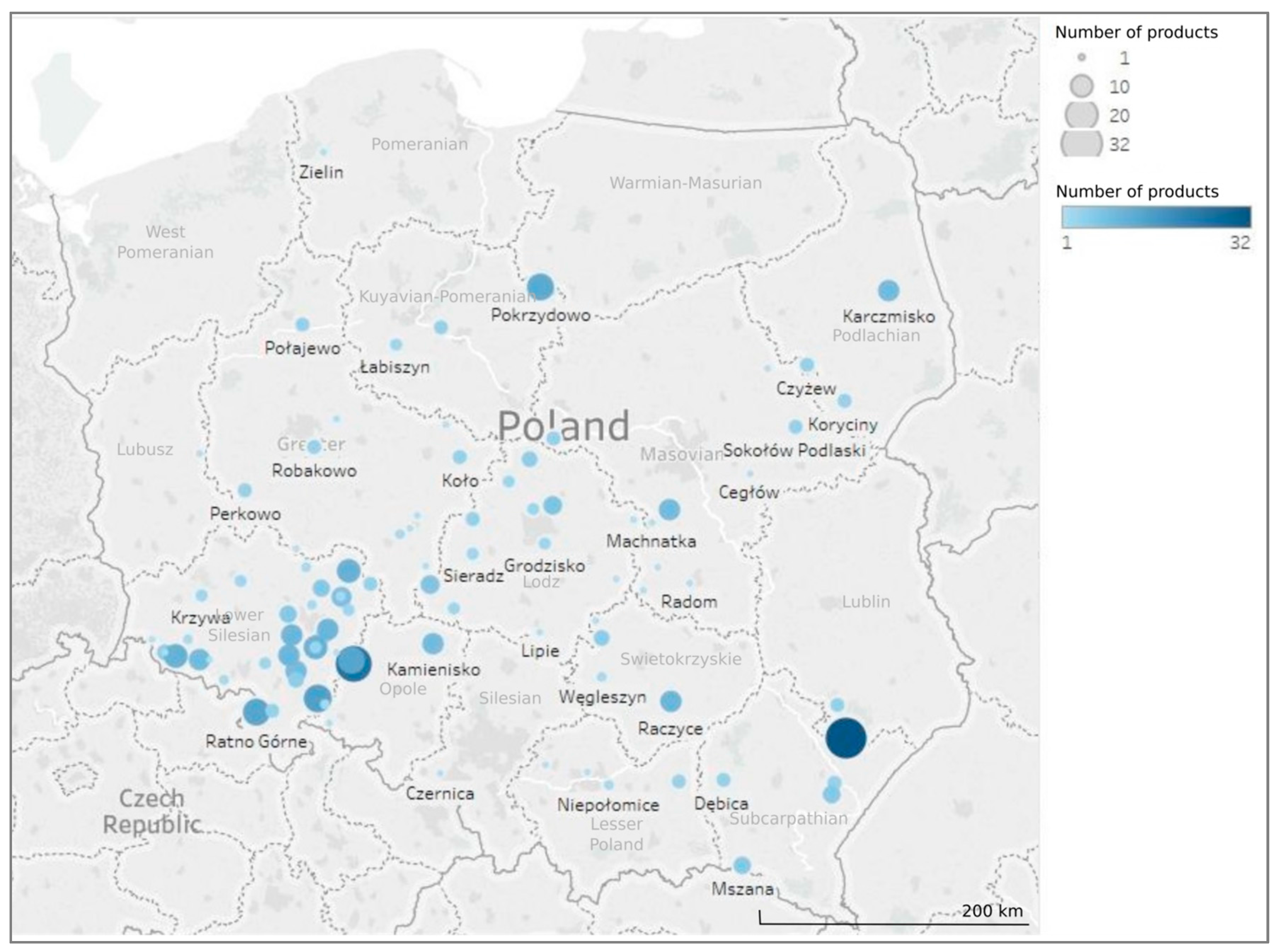
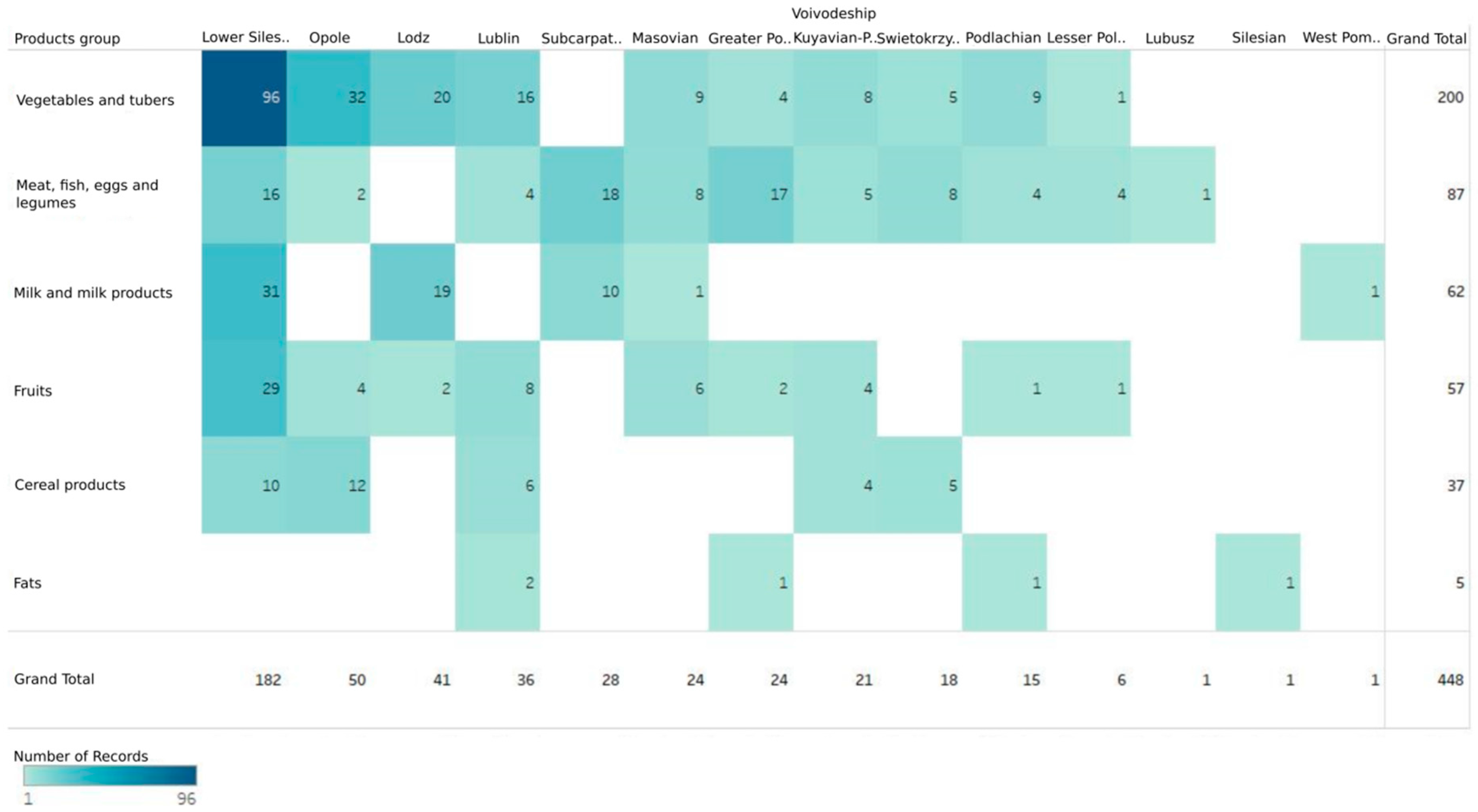
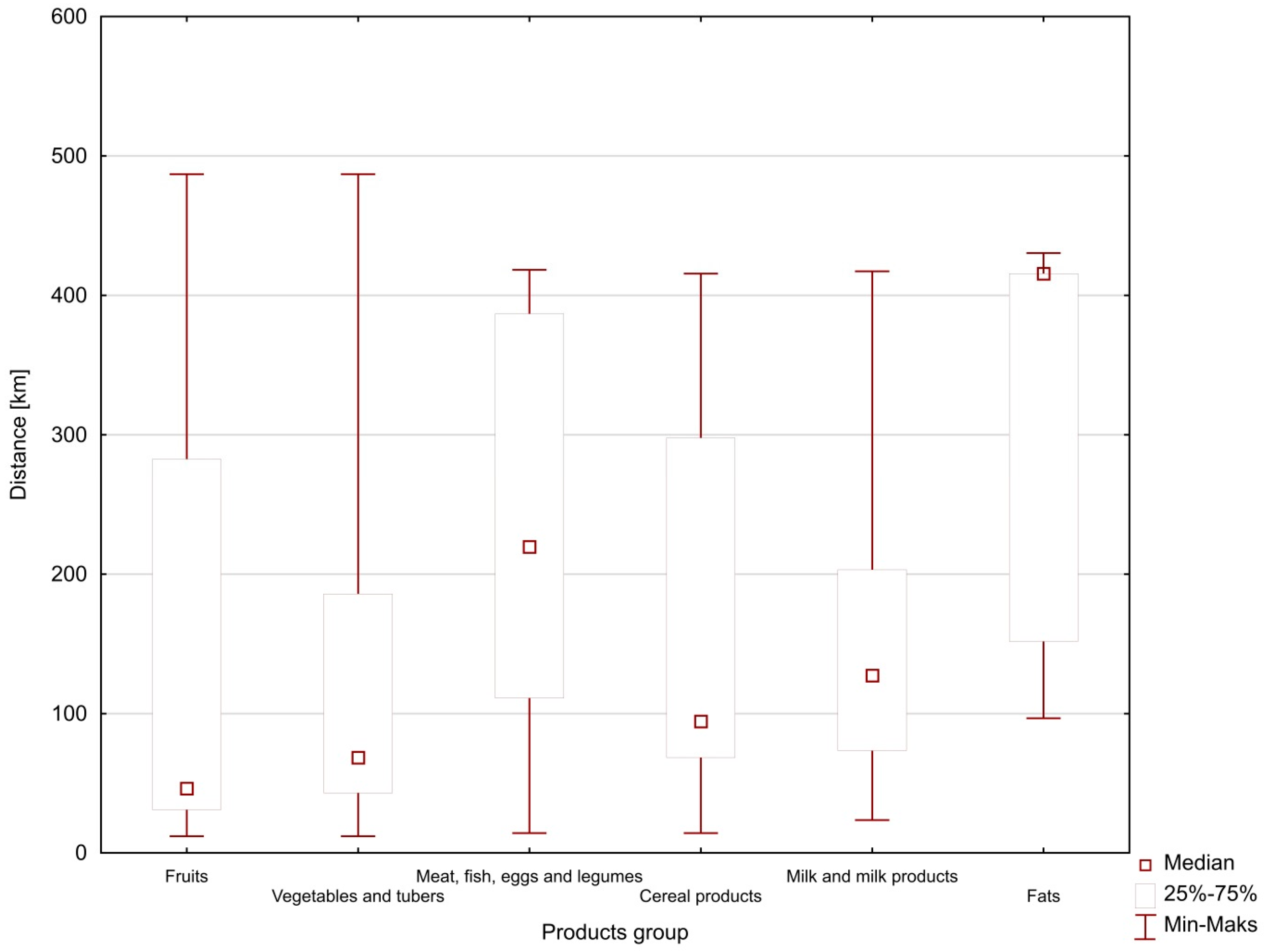
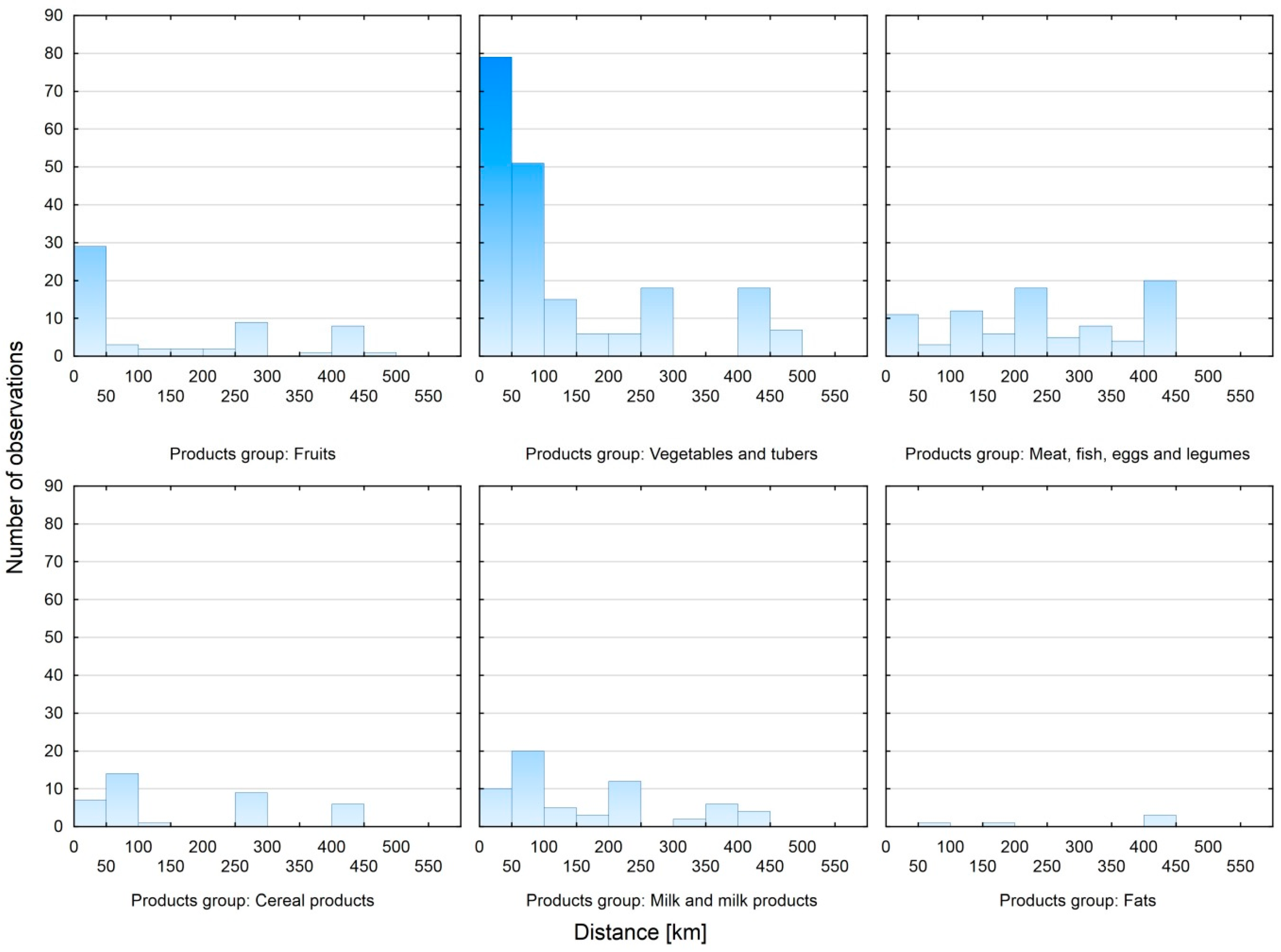


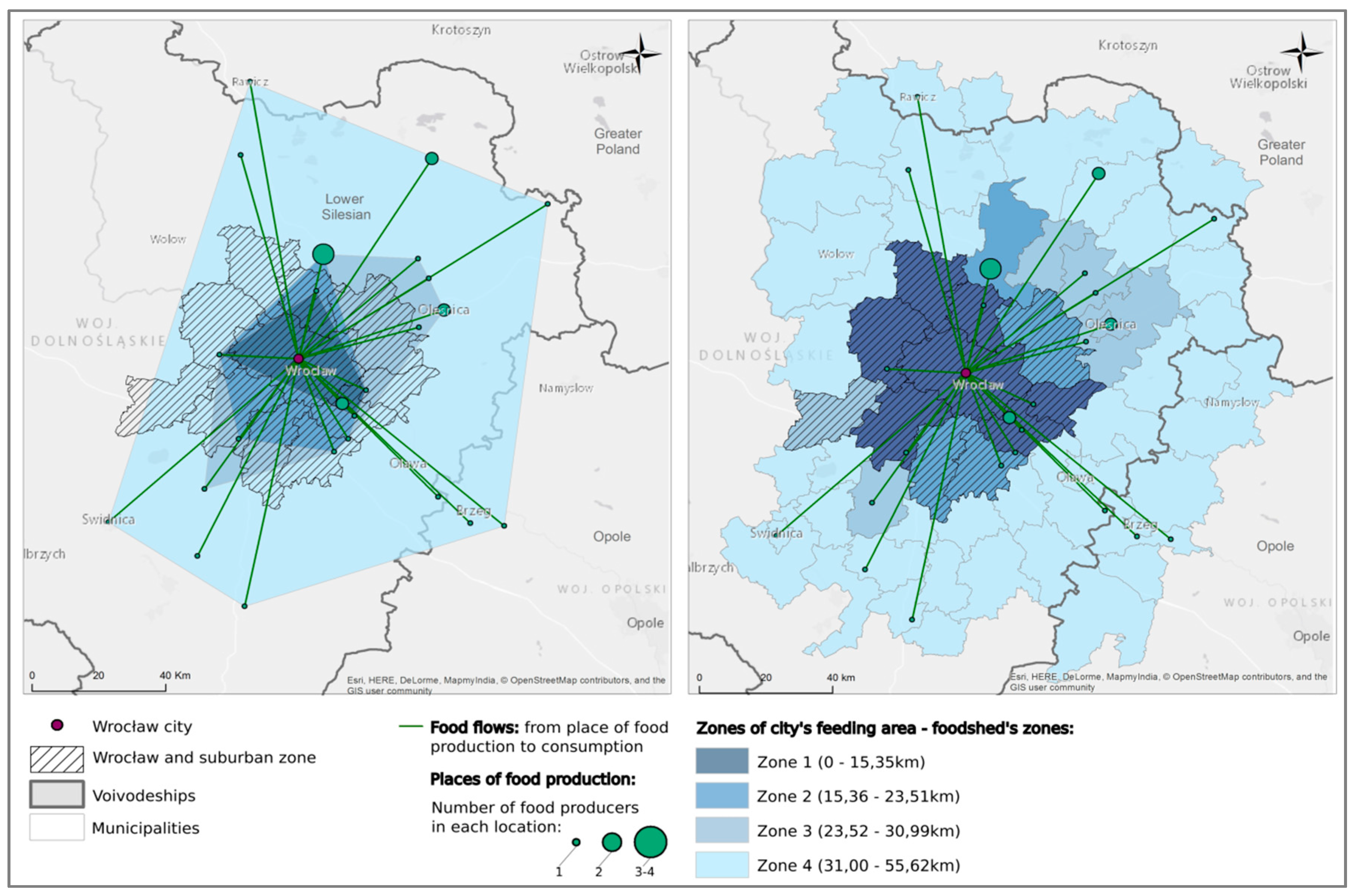
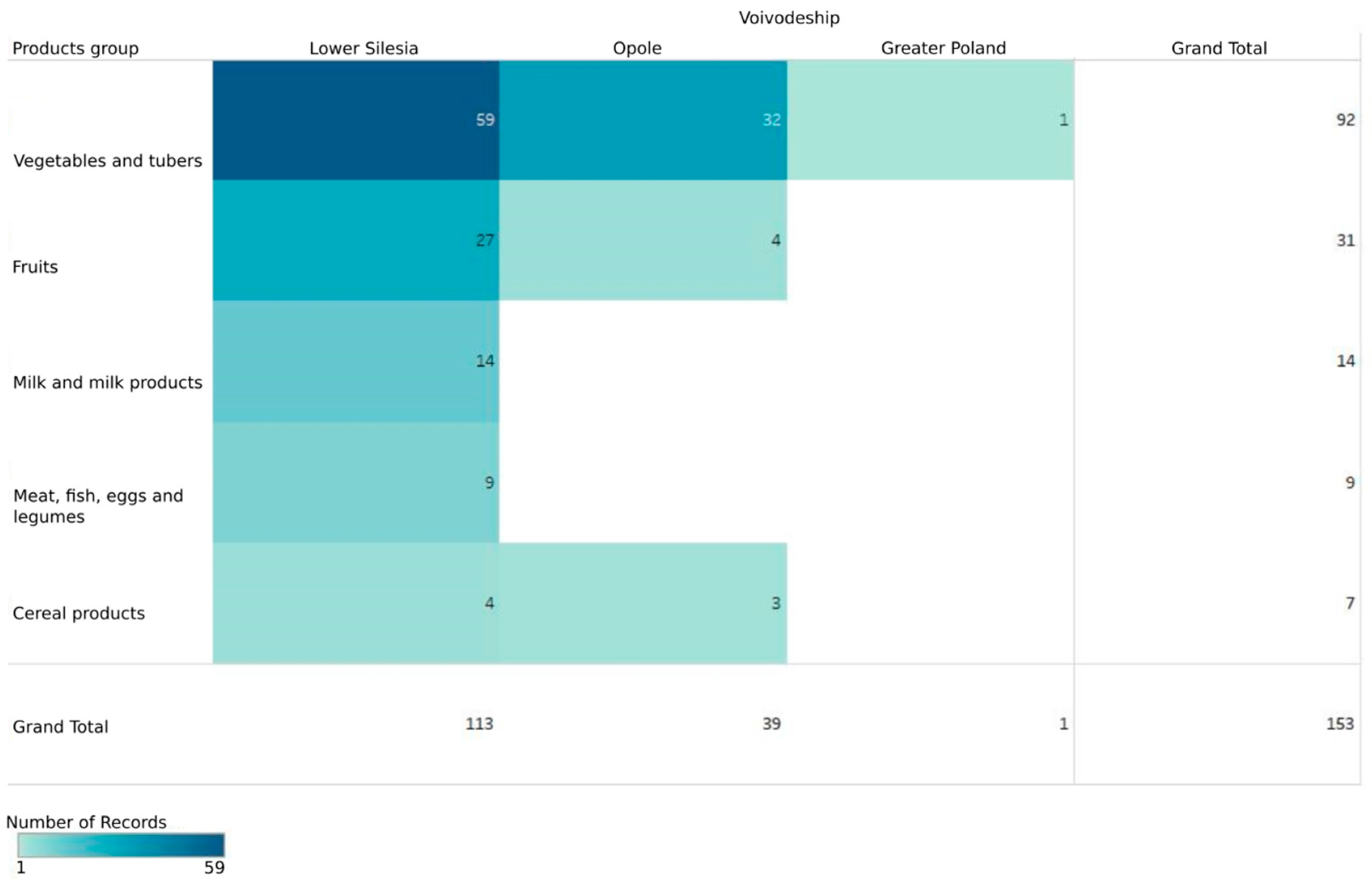
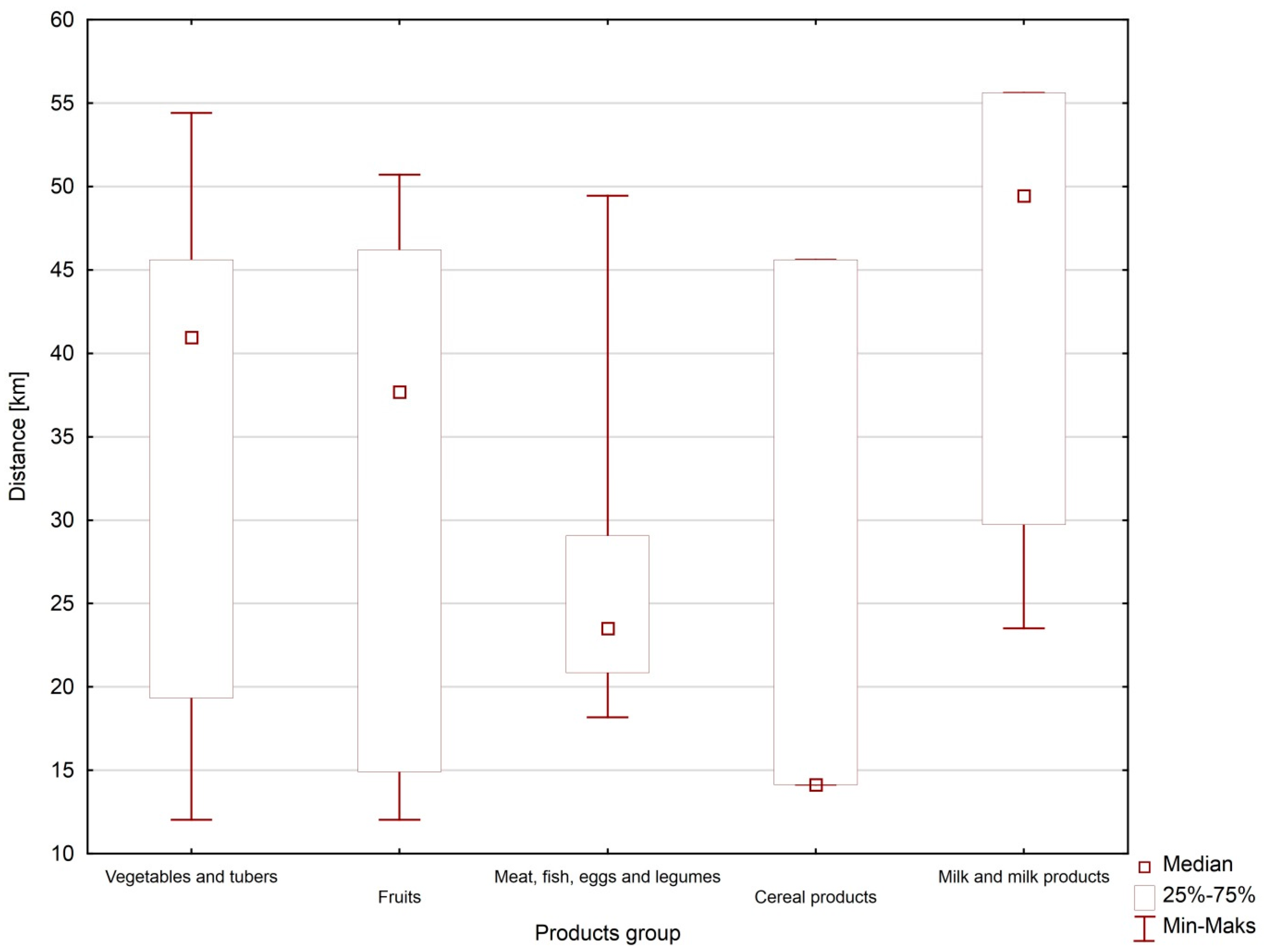
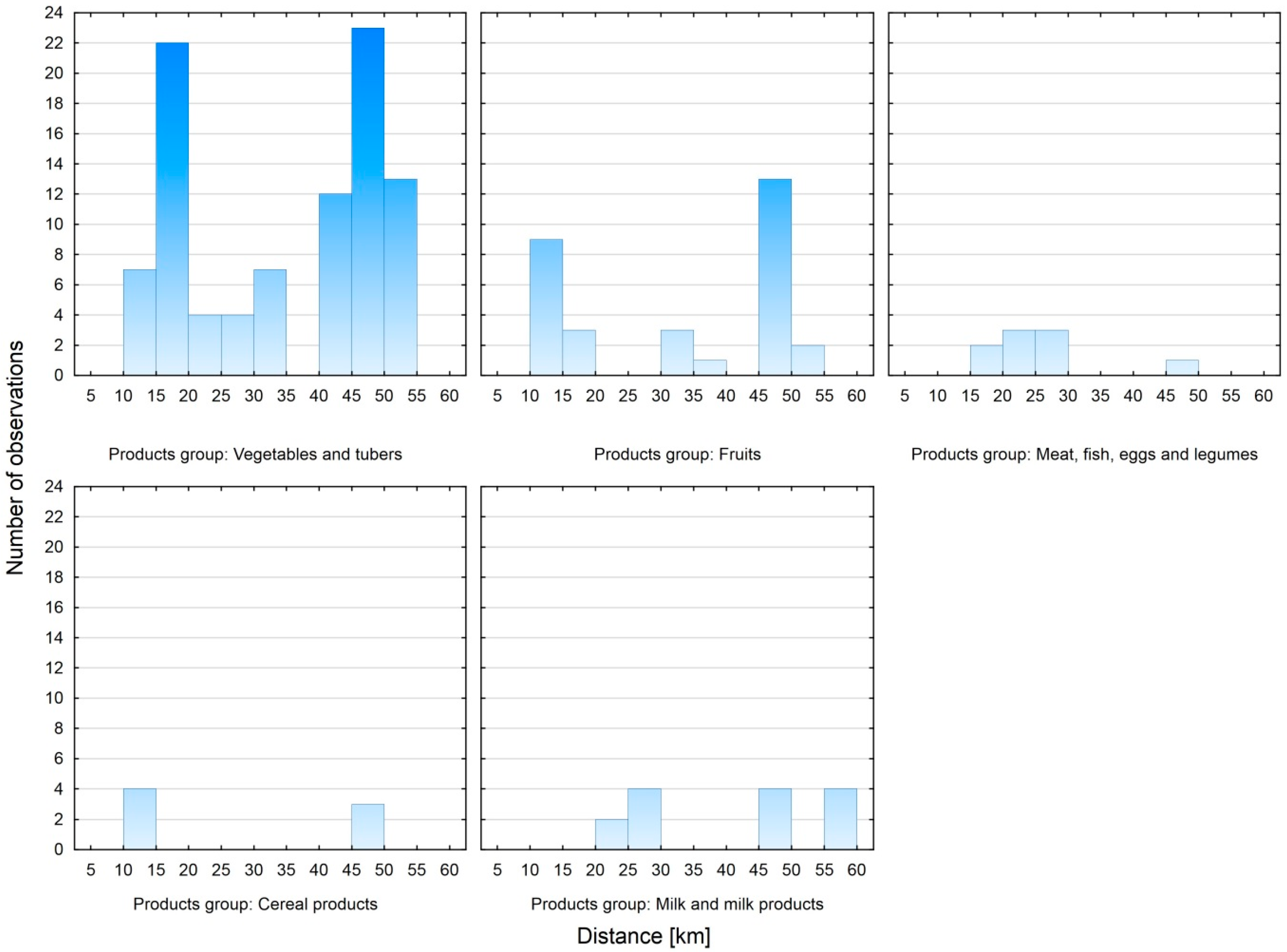
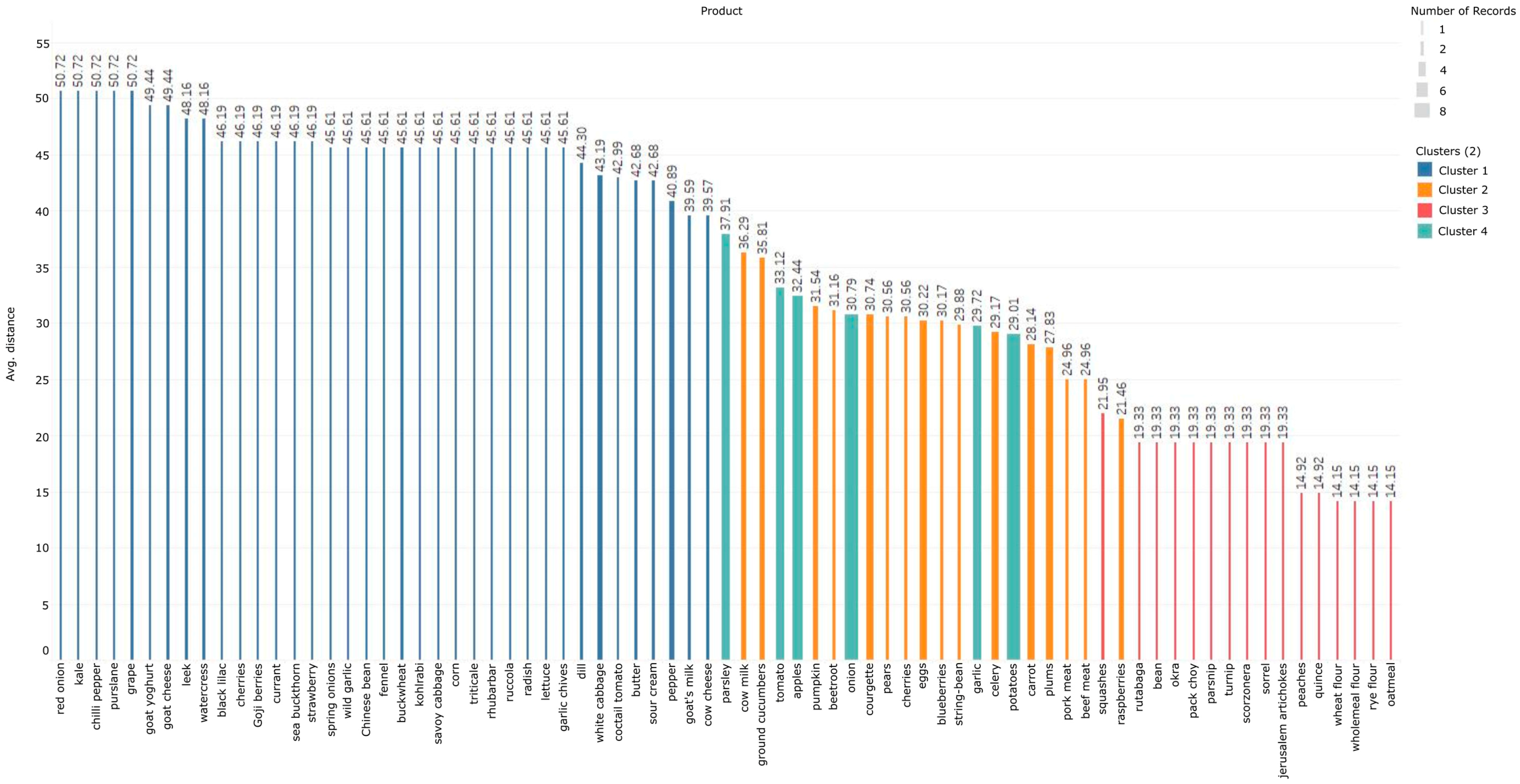
| TargPiast Marketplace | LSCAFWM | Bazaar at the Świebodzki | Market Square | Ekobazar | Bazaar ‘Krótka Droga’ | Wrocław’s Gourmets Bazaar | Local Farmer Initiative | |
|---|---|---|---|---|---|---|---|---|
| Public database/Website | x | x | x | x | x | |||
| Field research | x | x | x | x | x | |||
| Questionnaire/e-mails | x | x | x | x | x |
© 2018 by the authors. Licensee MDPI, Basel, Switzerland. This article is an open access article distributed under the terms and conditions of the Creative Commons Attribution (CC BY) license (http://creativecommons.org/licenses/by/4.0/).
Share and Cite
Świąder, M.; Szewrański, S.; Kazak, J.K. Foodshed as an Example of Preliminary Research for Conducting Environmental Carrying Capacity Analysis. Sustainability 2018, 10, 882. https://doi.org/10.3390/su10030882
Świąder M, Szewrański S, Kazak JK. Foodshed as an Example of Preliminary Research for Conducting Environmental Carrying Capacity Analysis. Sustainability. 2018; 10(3):882. https://doi.org/10.3390/su10030882
Chicago/Turabian StyleŚwiąder, Małgorzata, Szymon Szewrański, and Jan K. Kazak. 2018. "Foodshed as an Example of Preliminary Research for Conducting Environmental Carrying Capacity Analysis" Sustainability 10, no. 3: 882. https://doi.org/10.3390/su10030882
APA StyleŚwiąder, M., Szewrański, S., & Kazak, J. K. (2018). Foodshed as an Example of Preliminary Research for Conducting Environmental Carrying Capacity Analysis. Sustainability, 10(3), 882. https://doi.org/10.3390/su10030882







